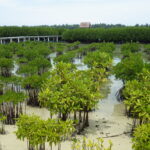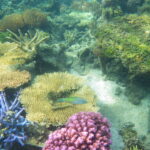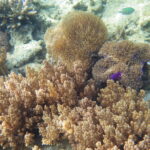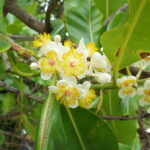Location
Kepulauan Seribu Utara Sub District
Area:
1,074.89 square kilometres
Date declared as an AHP:
2017
Unique Flora: The vegetation structure in KSNP is dominated by coastal vegetation such as coconut palm (Cocos nucifera), pandan (Pandanus sp.), screwpine (Pandanus tectorius), cemara laut or Australian sea tree (Casuarina equisetifolia), cangkudu or noni (Morinda citrifolia), butun or sea poison tree (Barringtonia asiatica), breadfruit (Artocarpus altilis), ketapang or Indian/sea almond tree (Terminalia catappa), kecundang (Cerbera odollam), and sentigi or pemphis (Pemphis acidula). KSNP is the habitat of 15 true mangroves including Avicennia marina, Bruguiera gymnorrhiza, Bruguiera cylindrica, Ceriops tagal, Rhizophora apiculata, Sonneratia alba, Sonneratia caseolaris, Lumnitzera racemosa, Xylocarpus granatum, Xylocarpus molluccensis, Xylocarpus rumphii, Aegiceras corniculatum, Pemphis acidulata, and Excoecaria agallocha, with Rhizophora stylosa as the dominant species.
Eight seagrass species have been identified in the national park, specifically Thalassia hemprichi, Halodule uninervis, Cymodocea rotundata, Syringodium isoetifolium, Halophila ovalis, Cymodocea serrulata, Halophila minor, and Enhalus acoroides.
Unique Fauna: Small islands in the park are surrounded by fringing reefs at depths of 1–20 metres. A total of 134 corals belonging to 68 genus and sub-genus have been identified in the park, including hard and massive corrals such as Monstastrea and Labophyllia, table corrals, sea fans (Gorgonians), leaf corals, mushroom corals, and soft corals. Hard corals are dominated by the families Acroporidae, Portidae, Faviidae, Fungidae, and Agaricidae. Other species are akar bahar or black coral (Antiphates sp.) Helioporidae sp., Scleractinia sp., and Tubiporidae sp.
Various ornamental fish species can be found in the national park including those from the families Chaetodontidae, Apogonidae, and Pomancanthidae. Economically important fish species have also been recorded, such as baronang (Siganus sp.), tenggiri (Scomberom sp), ekor kuning (Caesio spp), kerapu (Epinephelus sp) and tongkol (Eutynus sp). Other significant species include the whale shark (Rhincodon typus), giant Clam (Tridacna gigas), fluted giant clam/scaly clam (T. squamosa), and southern giant clam (T. derasa). Three species of dolphins have been identified in the park, including the common bottlenose dolphin (Tursiops truncatus), short beaked common dolphin (Delphinus delphis), and spinner dolphin (Stennela longirostris). Other marine species include seahorse, starfish, crinoid, sea cucumber, and sea urchin, and crustaceans such as crab, portunidae, and crayfish.
KSNP is also noted as a nesting site for the hawksbill and green sea turtle. Sea turtle nesting sites include the Pramuka, Penjaliran Timur, Gosong rengat, Karya, Yu islan, and Semak Daun islands. KSNP has established and developed conservation facilities such as a hatchery center, ranching/enlargement center, and reintroduction site on Pramuka and Kelapa Dua islands.
Three species of eagles have been monitored in KSNP, such as the brahminy kite (Haliastur indus), white-bellied sea eagle (Halaeetus leucogaster), and osprey (Pandion haliaetus). These species are targets of a rehabilitation program in KSNP, primarily through an eagle translocation program in Kotok Island in collaboration program with the Jakarta Animal Aid Network.
Waterfowl species are also found in Seribu Island such as the little ringed plover (Charadrius dubius), lesser sand plover (Charadrius mongolus), whimbrel (Numenius phaeopus), great crested terns (Sterna bergii), Pacific reef heron (Egretta sacra), and striated heron (Butorides striata).
Habitat Types: Combination of terrestrial and shallow marine ecosystems (coral reef, mangrove and seagrass), with 78 small islands.
With so many islands to choose from, Kepulauan Seribu National Park is an ideal destination for beach lovers and scuba divers. Some of the more popular attractions in the park are:
Pramuka, Semak Daun, Kelapa Dua, and Panggang Islands. Noted as turtle conservation areas, visitors can learn more about turtle hatching and protection, observe local wildlife, and enjoy swimming, snorkeling, and other water sports. Pulau Semak Daun is a small uninhabited island, which is best for those looking for peace and quiet in a rustic setting. Visitors can set up tents, and enjoy unlimited snorkeling and diving.
Bira Island. Pulau Bira has maintained a pristine environment due to its distance from the other islands in KSNP. Visitors will have to travel three hours from Muara Angke Pier and transit through Pulau Pramuka before reaching Pulau Bira. Vintage wooden houses are available for overnight accommodations.
Sepa, Putri, Pelangi, and Pantara Islands. These islands offer many marine tourism activities managed professionally by the private sector. Pulau Sepa is a popular day trip destination, with facilities for overnight stays. While Pulau Putri is among the most remote islands in the park, it has complete facilities including a jetty, restaurant, cottages for overnight accommodations, and tennis court. It is also equipped with water sports and recreation facilities such as swimming pool, dive shop, water bike, banana boat, and glass bottom boat. The glass bottom boat and an undersea tunnel aquarium provide other opportunities to enjoy underwater life. Visitors can avail of a sunset cruise around the islands. Pulau Pantara is also remote with facilities similar to Pulau Putri.
Panggang, Pramuka, Kayu Angin Genteng, Pulau Kotok Besar, and Kotok Kecil Islands, and Gosong Sepa. Aquatic areas in these islands are the best places for diving and snorkeling.
Pari Island. The island offers sandy white beaches, snorkeling and diving opportunities, and an opportunity to visit seaweed cultivation facilities. Pulau Pari also serves as a center of marine research of the Indonesian Institute of Sciences (LIPI).
Harapan Island. Pulau Harapan is known for beautiful coral reefs that make divers linger in the water. The island also faces the sanctuary of the bondol or brahminy kite (Haliastur indus).
Bidadari Island. Found only 15km away from Jakarta, Pulau Bidadari has interesting local history and charming mangrove forests.
Ayer Island. Also known as the Pearl of the Thousand Islands, Pulau Ayer has cottages built with traditional Papua designs. People of distinction have been known to visit the island since the 1950s.





